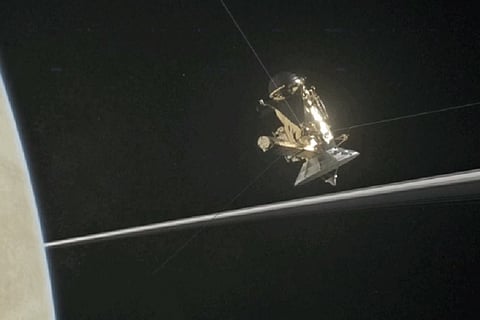

Cassini's first-ever dive through the narrow gap between the planet Saturn and its rings on April 26 was successful and the spacecraft is now in the process of beaming back science and engineering data collected during its passage, NASA said on Thursday.
NASA's Deep Space Network Goldstone Complex in California's Mojave Desert acquired Cassini's signal at 2:56 a.m. EDT on Thursday and data began flowing at 3:01 a.m. EDT, the US Space agency said.
"I am delighted to report that Cassini shot through the gap just as we planned and has come out the other side in excellent shape," said Cassini Project Manager Earl Maize of NASA's Jet Propulsion Laboratory in Pasadena, California.
Images captured by Cassini spacecraft during its first "Grand Finale" dive past the planet have also been published.
The unprocessed images show features in Saturn's atmosphere from closer than ever before.
.jpg?w=640&auto=format%2Ccompress)
This unprocessed image shows features in Saturn's atmosphere from closer than ever before. The view was captured by NASA's Cassini spacecraft during its first Grand Finale dive past the planet on April 26, 2017. Credit: NASA/JPL-Caltech/Space Science Institute
"In the grandest tradition of exploration, NASA's Cassini spacecraft has once again blazed a trail, showing us new wonders and demonstrating where our curiosity can take us if we dare," Jim Green, Director of the Planetary Science Division at NASA Headquarters in Washington said.
As it dived through the gap, Cassini came within about 3,000 kilometres of Saturn's cloud tops and within about 300 kilometres of the innermost visible edge of the rings.
While mission managers were confident Cassini would pass through the gap successfully, they took extra precautions with this first dive, as the region had never been explored.
.jpg?w=640&auto=format%2Ccompress)
Credit: NASA/JPL-Caltech/Space Science Institute
The gap between the rings and the top of Saturn's atmosphere is about 2,000 kilometres wide.
The best models for the region suggested that if there were ring particles in the area where Cassini crossed the ring plane, they would be tiny, on the scale of smoke particles.
.jpg?w=640&auto=format%2Ccompress)
Credit: NASA/JPL-Caltech/Space Science Institute
The spacecraft zipped through this region at speeds of about 124,000 kph relative to the planet, so small particles hitting a sensitive area could potentially have disabled the spacecraft.
As a protective measure, the spacecraft used its large, dish-shaped high-gain antenna as a shield, orienting it in the direction of oncoming ring particles.

An illustration showing Cassini diving through a plume of Saturn's moon Enceladus in 2015; Source: NASA/Facebook
Cassini's next dive through the gap is scheduled for May 2.
Launched in 1997, Cassini arrived at Saturn in 2004.
.jpg?w=640&auto=format%2Ccompress)
Credit: NASA/JPL-Caltech/Space Science Institute
Following its last close flyby of the large moon Titan on April 21, Cassini began what mission planners are calling its "Grand Finale."
The gap between Saturn and its rings is no longer unexplored space – and we're going back 21 times. #GrandFinale! https://t.co/TSA7uQe4KS pic.twitter.com/t9RlhEsWCP
— CassiniSaturn (@CassiniSaturn) April 27, 2017
During this final chapter, Cassini loops Saturn approximately once per week, making a total of 22 dives between the rings and the planet.
The spacecraft is on a trajectory that will eventually plunge it into Saturn's atmosphere -- and end Cassini's mission -- on September 15.